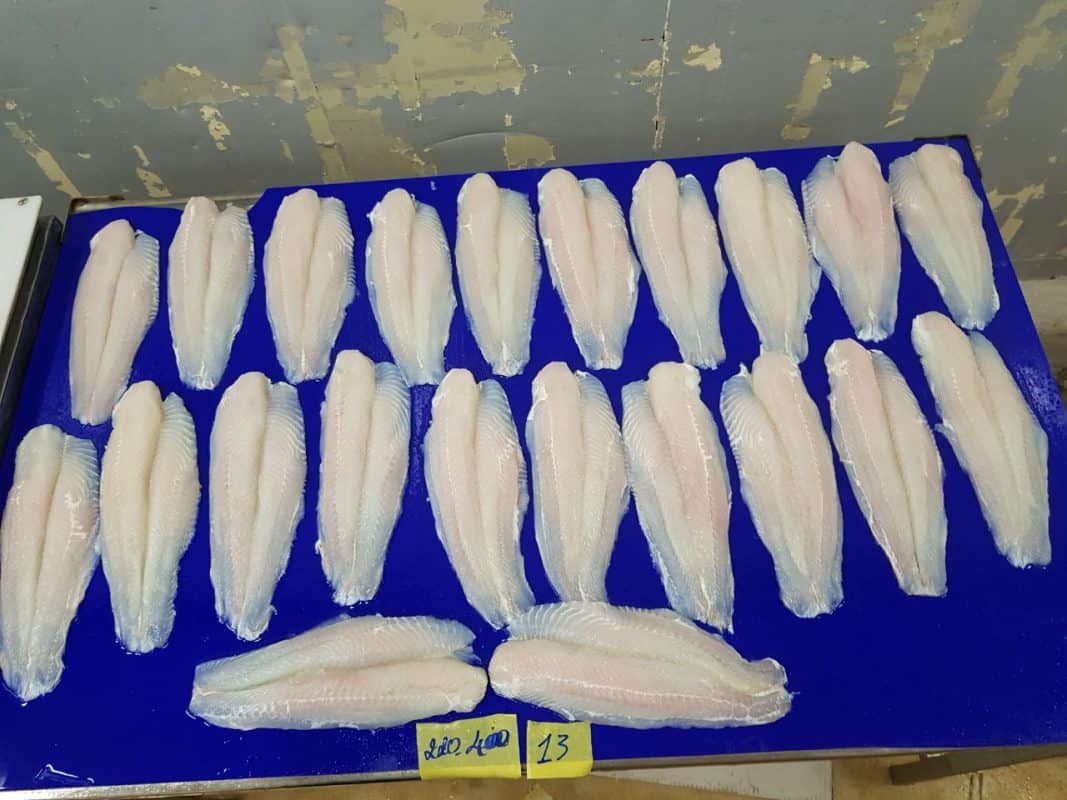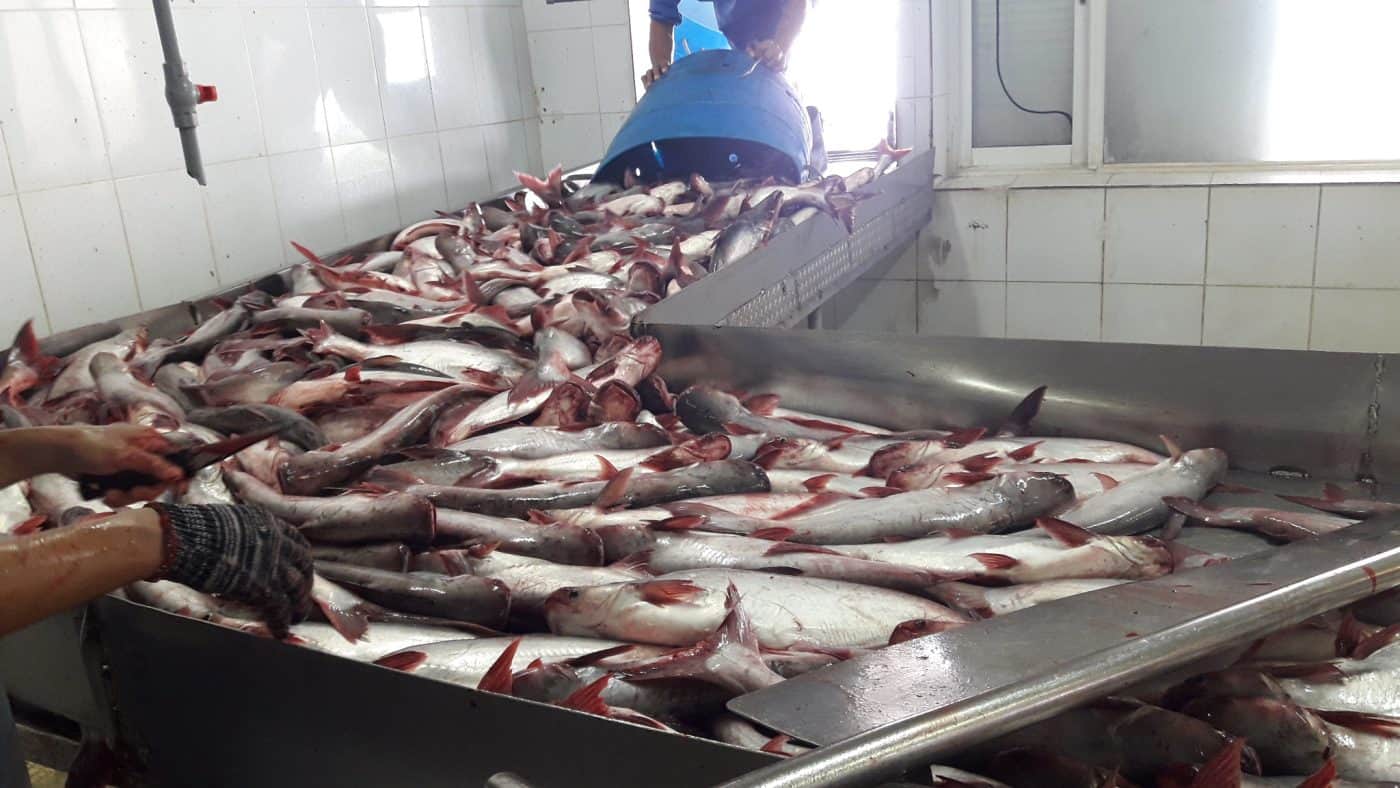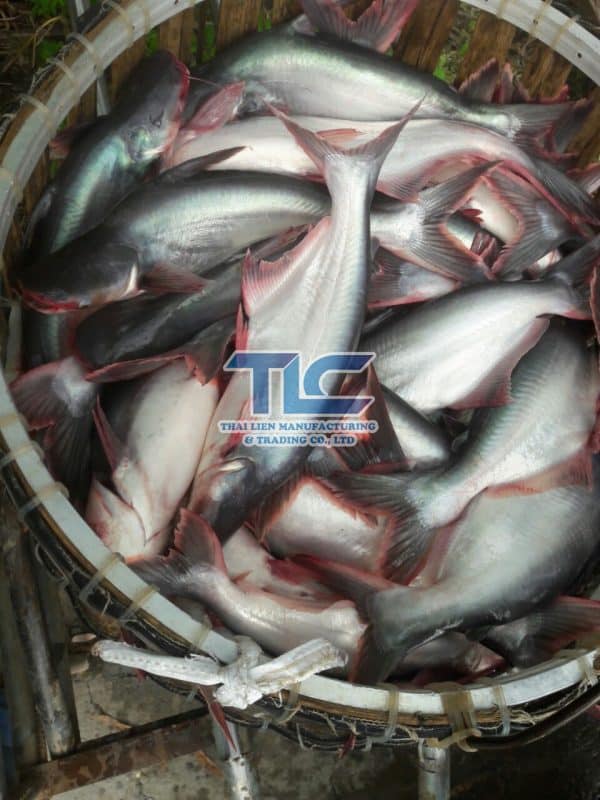Pangasius, scientifically known as Pangasius hypopthalmus is a large freshwater catfish indigenous to the countries within the Mekong Delta. It is regarded as the third most important freshwater aquaculture species because of its fast growth, hardiness and versatile feeding habit.
Pangasius is also known as cream dory, tra, swai or striped catfish in the fish food market or Siamese shark or sutchi in the aquarium hobby. It was introduced in the Philippines both by the private sector and the Bureau of Fisheries and Aquatic Resources as an alternative species for freshwater aquaculture.

Pangasius is an air-breathing fish that can grow normally even at low dissolved oxygen levels of 0.1 mg/L, making it adaptive and tolerant in poor water quality. Under intensive aquaculture conditions the species will reach harvest size of one kilogram in approximately six to seven months and requires low protein feeds. It is the fast-growing fish in the aquaculture sector with 35 to 45 percent meat recovery.

Body
Pangasius has a scaleless skin with quite long slender body with black to dark gray on the dorsal portion and light gray on the lateral side and whitish on the abdominal portion parallel along the lateral line. Total body length is four to five times of its head length and standard length is almost/nearly four to five times of the body width.

Mouth
With a wide mouth and curvature (not sharp) located in quite low position give the fish the ability to feed on a variety of food items (omnivorous). Two (2) pairs of barbells are situated in the mouth – one pair on the upper jaw (maxillary barbell) and another pair on the lower jaw (mandibulary barbell); the first pair is longer than the latter.

Fins
The fins are classified into dorsal, caudal, adipose, ventral and anal fin. The dorsal fin consists of one hard fin ray (spine like saw) and six (6) soft fin rays. An adipose fin is situated between the dorsal and caudal fin. The caudal fin is isocoercal and anal fin consists of four (4) hard rays and 30-32 soft fin rays. The pectoral fin composed of eight to nine (8-9) soft fin rays.
Sexual Dimorphism and Breeding
Under normal conditions Pangasius becomes sexually mature during the 2nd year. In some ponds where conditions are not favorable to this growth the period is considerably longer.
A gravid female have a bulging belly which is swollen and soft while the urogenital-oval shape is reddish in color which is much bigger than the male. The release of yellow eggs is eminent when abdomen is pressed or when holds at the caudal and fold its body above water. While the male have a slender body and belly is not swollen. The urogenital-oval shape is narrow and smaller than the female and when the belly is pressed, it releases white milt.

Hatching period is from 27 to 32 hours after spawning at temperature of 28 to 31°C. The fertilized eggs are sticky and spherical in shape. It is 1.186 mm in diameter, contains large quantity of yolk and has a yellow greenish color. The newly hatched fry which is approximately three mm in length is colorless and transparent with no signs of movement from one to two hours then after, it swims in vertical direction until three days old.
After absorption of the yolk sac, the freshwater hammerhead shark fry differs from other fish that it will begin to eat food and has cannibalism behavior. The three days old fry can swim horizontally and its organ will completely develop as the fish mature and reaches its 14 days.
Feed Conversion Ratio (FCR)
Pangasius has the ability to grow from 20 gram fingerlings to one kilo in six months with a feed conversion ratio (FCR) of 1.5 (you produce one kilo of fish meat with 1.5 kilos of feed).
Survival Rate
The fish has a survival rate of almost 100 percent, and production cost less than Php40 per kilo. It can be stocked intensively at the rate of 300,000 fish per hectare without requiring mechanical aeration. When filleted it becomes a “generic white fish” that is now used by restaurants as a replacement for the more pricey marine fish.
Care and Feeding
Being omnivorous, the Pangasius generally eat all kinds of live, fresh, and flake foods. To keep a good balance, a high quality flake food or pellet may be supplied every day. As the fish get older, they lose their teeth and become more and more vegetarian. The use of insecticides, antibiotics, waste water and leftover food discharge to pond and other illegal chemicals is not encouraged for this will prevent growth of pangasius.
Culturing
Pangasius can be cultured in fishponds, concrete fish tanks, fish cages and fish pens with the acceptable water conditions:
- Hardness Of 2-20 dGH;
- Ph of 6.5 to 7.5,
- temperature of 72-79° F(22-26° C); and
- at least 45mg/l of dissolved oxygen in the pond from naturally producing oxygen from phytoplantons or mechanical aerator.
Rearing in Earthen Pond
The pond should be roughly 1,600 square meters or at least 400 square meters. The growth of the Pangasius is fast, requiring depth of approximately 1.5 to two meters. The pond should be situated near a water source in order to fetch in and extract water. Pond preparation is the same as general preparation for other fish ponds. Water to be used in the pond must have a fitting pH value and a proper oxygen concentration. Fingerlings to be used should be selected based on the healthiness of the fish – without wounds, no abnormalities and no disease and approximately all same size to keep them away from fighting for food. Pellet feeds are advisable for feeding to ensure faster growth.
Stocking rate is about 10 to 15 fish per square-meter. Given the proper feeding and management, it can grow to one to 1.5 kilo in five to six months time. Catching the Pangasius can be conducted using suitable net.
Rearing in Floating Cages
Location of floating cages should be near flowing water like rivers, dams and lakes. Size of cages should be 10 × 10 meters by five meter depth. Stocking rate is about 30 to 50 fish per cubic meter. Food for feeding are pellets, trash fish including water plants and small animals such as insects and worms. Harvest is much easier in cages compared to earthen pond.
Diseases
Similar to other fishes, the Pangasius can get diseases such Ichthoyophthirius species parasite, the trichodina species parasite, inflammation of stomach disease, diseases from the dactylogyrus species parasite or flat-body parasite and the rice-shape wart disease. Thus, it is important to have traceability of the production (from processing plant to farm hatchery and feed mill) and an appropriate culturing environment (site selection and production practices, as well as sanitation).
Using pellet feeds can somehow prevent diseases in Pangasius since food is controlled, however, prevention is still the best cure through sustainable culturing, good management and efficient water supply.
Harvesting
After six months, the fish is harvested by dragging in the nets and transporting the catch alive in well-boats to the factories. The fish can be harvested all year round.
For further information, please contact
TLC-THAI LIEN MANUFACTURING & TRADING CO., LTD
- Address: Perfect Tower, 6th floor, 150Bis Le Thi Hong Gam street, Cau Ong Lanh Ward, District 1, HCMC, Vietnam
- Mobile/Wechat/Whatsapp: +84.789.196.398 / +84.908.794.118
- Email: thaiphuong@tlcthailien.com – fionathai.thailientlc@gmail.com
- www.tlcthailien.com
- Fanpage: Thai Lien Viet Nam
and Bargains in Vietnam Black Tiger Shrimp: Nutrition black tilapia brunei Distinguishing White Pomfret from Black Pomfret Dried Fish Skin & Scale Benefit dubai seafood import Explaining Tuna Saku Specifications Fish Skin Salted Egg frozen pangasius fillet frozen pangasius fillet product Frozen Pangasius Fillet Products in Vietnam Frozen Pangasius Fillet Specs & Tips for Buying frozen pangasius sliced frozen pangasius steak frozen pangasius whole round frozen pangasius whole sale Frozen Seafood Export Market in Vietnam for 2024 grouper How Long Does Frozen Seafood Take to Boil? hải sản đông lạnh có tốt không? Instructions for Defrosting Seafood Products Properly pangasius pangasius fish market Premium Black Tiger Prawn Seabass Fish: A Culinary Delight snakehead fish Sourcing Specifications of Vietnamese Shrimp Products Today thaifex 2024 thailien Their Benefits for Health Top 5 Benefits of Indian Mackerel Fish Top 5 Effects of Collagen and Ossenin on the Skin Top 5 Nutritious Dishes from Shrimp: A Culinary Delight Types of Exported Shrimp Dominating the Vietnamese Market Today Understanding Shrimp Grading Vannamei Shrimp vs. Black Tiger Shrimp vs. Scampi Prawn Vietnam Frozen Seafood Industry 2023: Navigating Trends and Challenges What is Black Pomfret What is Pangasius Fish? What is Red Tilapia Fish: Top 5 Benefits what is sardine fish What is Seabass Fish What is the difference between ossein and collagen
- Thai Lien Company Shines at Thaifex 2024 Conference!
- Unlocking the Secrets of Black Tiger Shrimp: Nutrition, Sourcing, and Bargains in Vietnam
- Unlocking the Potential: Insights into the Anticipated Frozen Seafood Export Market in Vietnam for 2024
- Unveiling the Exceptional Specifications of Vietnamese Shrimp Products Today
- Exploring the Exceptional Specifications of Frozen Pangasius Fillet Products in Vietnam
and Bargains in Vietnam Black Tiger Shrimp: Nutrition black tilapia brunei Distinguishing White Pomfret from Black Pomfret Dried Fish Skin & Scale Benefit dubai seafood import Explaining Tuna Saku Specifications Fish Skin Salted Egg frozen pangasius fillet frozen pangasius fillet product Frozen Pangasius Fillet Products in Vietnam Frozen Pangasius Fillet Specs & Tips for Buying frozen pangasius sliced frozen pangasius steak frozen pangasius whole round frozen pangasius whole sale Frozen Seafood Export Market in Vietnam for 2024 grouper How Long Does Frozen Seafood Take to Boil? hải sản đông lạnh có tốt không? Instructions for Defrosting Seafood Products Properly pangasius pangasius fish market Premium Black Tiger Prawn Seabass Fish: A Culinary Delight snakehead fish Sourcing Specifications of Vietnamese Shrimp Products Today thaifex 2024 thailien Their Benefits for Health Top 5 Benefits of Indian Mackerel Fish Top 5 Effects of Collagen and Ossenin on the Skin Top 5 Nutritious Dishes from Shrimp: A Culinary Delight Types of Exported Shrimp Dominating the Vietnamese Market Today Understanding Shrimp Grading Vannamei Shrimp vs. Black Tiger Shrimp vs. Scampi Prawn Vietnam Frozen Seafood Industry 2023: Navigating Trends and Challenges What is Black Pomfret What is Pangasius Fish? What is Red Tilapia Fish: Top 5 Benefits what is sardine fish What is Seabass Fish What is the difference between ossein and collagen



